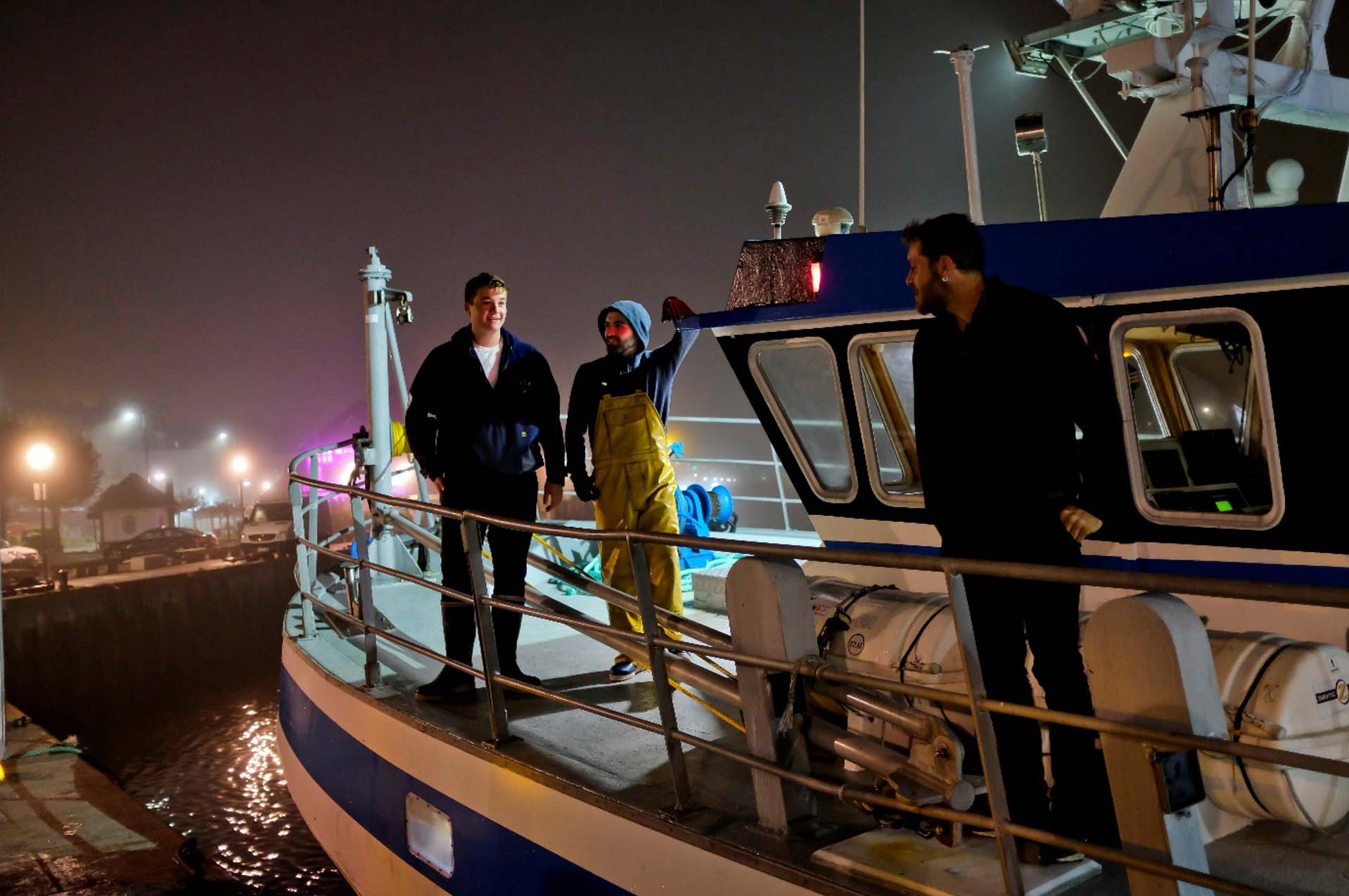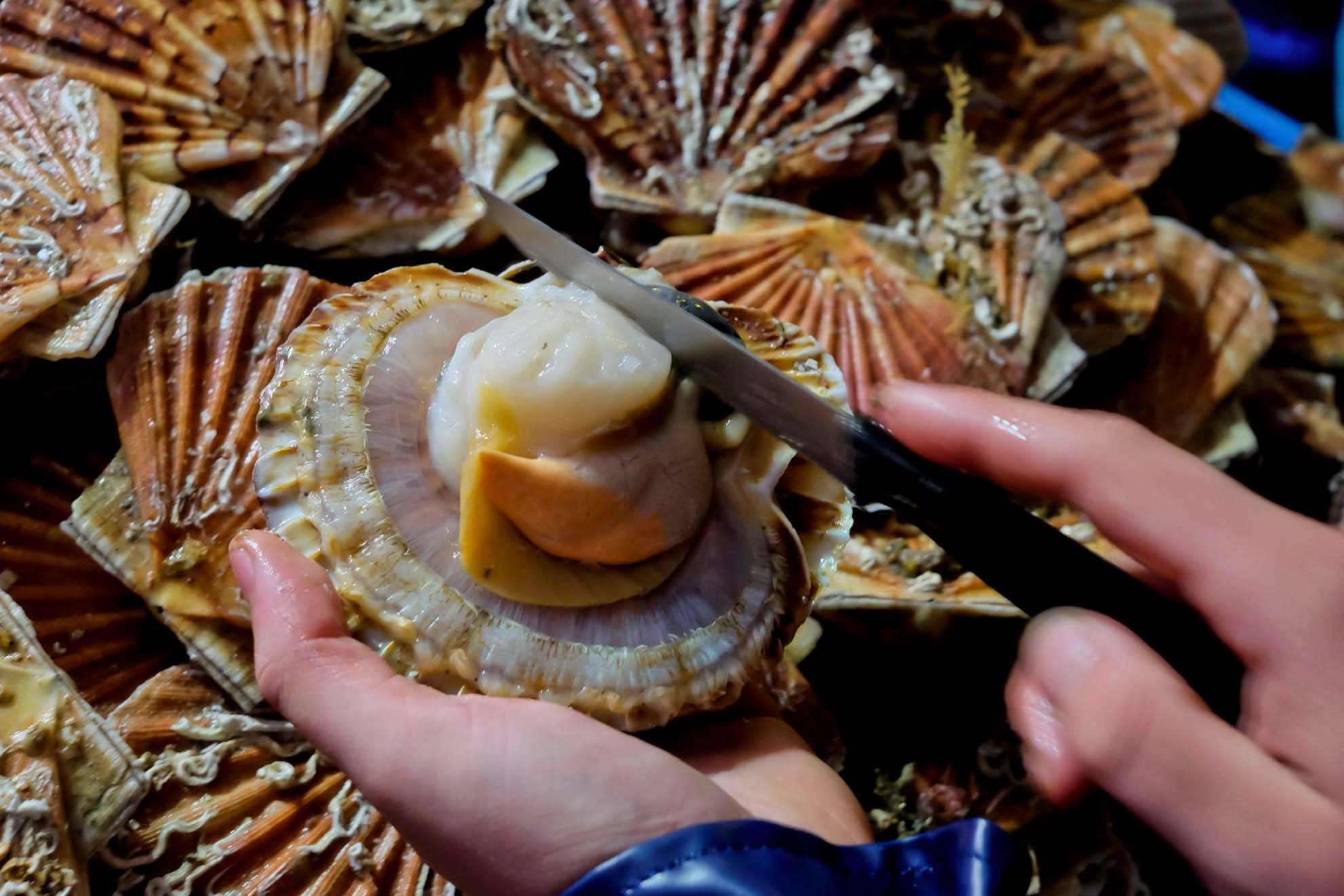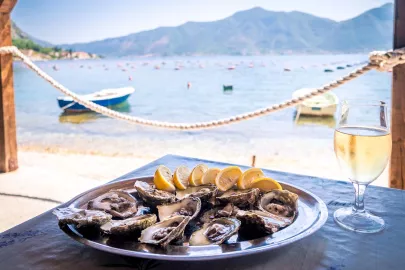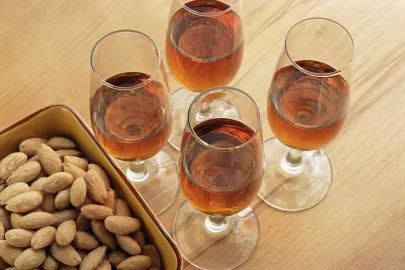The crew of the Gros Loulou told us to meet them at the port of Trouville in Normandy. The king scallop will be their sole focus for the next few weeks. Pull on your sailor sweaters and knit caps. It's time to watch the "pack out" of the season's first king scallops!
The lights of the Gros Loulou, a 53-foot fishing vessel, shine through the fog on an early autumn morning. It is 5:30 a.m. The quiet rumble of the engine grows louder as the ship approaches the wharf. The side lightly scrapes against the wooden platform as it docks. It's just over 50 °F at Trouville's port. I shiver in my hooded down jacket as I breathe in the ship's diesel fumes alongside Arnaud Perchey, the owner of Gros Loulou, and his 17-year-old son, Brice. Two strapping young men wearing tall boots walk out onto the ship's deck. One is wearing a hooded yellow sailor's jacket, while the other, a redhead with a beard, is dressed in a blue-and-white-striped sweater. Wordlessly, they spring into action at the front of the Gros Loulou, wholly concentrated on their precise and powerful actions. The front hatch opens, light shines out of the hold, and the winch is guided towards the opening with a quiet creak.
Soon after docking, the first crate is brought out, followed by several others, all of which are stuffed full of king scallops that have been collected over night.

The "pack out," or the unloading of the ship's cargo in sailors' lingo, is about to start. Soon after docking, the first crate is brought out, followed by several others, all of which are stuffed full of shiny and fresh king scallops that have been collected over night. The sailor in the yellow jacket carefully and immediately guides each crate to the refrigerated truck parked along the dock. Outside of the vehicle, his hands turning red with the cold, Arnaud and his son quickly stack the crates in a well-rehearsed ballet. In just a few minutes, the truck is full. The tall, red-headed sailor in the striped sweater—I learn he is the captain of the Gros Loulou—takes a few minutes to smoke a cigarette while speaking with his boss about the fishing vessel's next plans. "See you tomorrow, guys!" By the time the bell from the village's church marks 6:00 a.m., the ship and its crew are already heading out to sea for another 24 hours of fishing. Scallop fishing is less of a job than a calling. It took less than 30 minutes to unload the boat, which is now cutting its way towards the horizon, leaving behind a gust of icy air that whips across my face. The weather is good, and the sea is calm. Scallop season waits for no one.
Scallop fishing is less of a job than a calling. It took less than 30 minutes to unload the boat...

An exciting and dangerous profession
From October to mid-May, the crew of the Perchey family's ship is hard at work, fishing six days a week. For four weeks of the season, the crew fishes solely for king scallops. They do so by deploying trawl nets in authorized areas that scrape the sea floor and gather up the famous king scallops, which are buried in the sediment. The fishermen are only allowed to use this method during specific times of the day. King scallop fishing is a dangerous and precise affair. It is also highly regulated because the deposits where these delicious wild shellfish can be found are protected. The scallops are captured in a bag made out of a metal grid on the bottom and a net on top. Once the bags are full, they are brought back to the surface through a very dangerous maneuver. With the slightest mistake, the metal combs can catch a foot and drag the fisherman into the sea.

"Out at sea, the nets can sometimes catch 2 tons of rocks for every 80 pounds of scallops. You catch very little, and it is a physically demanding job," explains Arnaud Perchey. "The scallops are sorted on the deck of the boat, and only the largest ones are kept. These are 4-5 inches in diameter. Smaller scallops are thrown back in the sea so they can continue to grow," he says. Once they are sorted, they are placed in crates and stored at a cool temperature in the hold.
Fishing is a very physical and dangerous job that you can't do for long.

A trip to the market
It is 6:15 a.m. Back in the truck, we drive across Trouville to the Percheys' icemaker. The town is still asleep. Arnaud quickly climbs into the ice bin with a shovel in hand. As his son, Brice, removes and reloads the crates, Arnaud covers each one with a shovelful of ice chips. Now that they are covered with ice, the scallops will retain a peak level of freshness. We quickly load up again to drive to the market in nearby Deauville, one of the most traditional markets along Normandy's shores. There, his wife and parents are already busy setting up their booth.
It is 7:00 a.m. Their cheeks turning red with the cold, the family takes a few moments to enjoy a coffee and croissant at the corner cafe and warm up. Arnaud, a true fisherman, is a man of few words. His every gesture and comment is measured as he quietly shares his passion for fishing, and king scallop fishing in particular. At age 42, he will soon step aside so his son can take control of the ship. "Fishing is a very physical and dangerous job that you can't do for long." The sea takes its toll, but it's for a good cause—treating customers to the best wild-caught scallops in the world. "What I love about king scallops," says Arnaud Perchey, smiling, "is their slightly sweet flavor, that hint of hazelnut, and how easy they are to eat."

It is 7:30 a.m. Several boxes of king scallops are laid out on a thick layer of crushed ice next to red mullets, soles, flounders, and squid. The family booth is ready to serve its first customers even though it's barely even dawn.
They get busy preparing the day's orders. Two, four, six, ten. The Perchey family quickly counts and fills up dozens of bags, which creak and clang together. The day's catch totaled close to 1,600 pounds! Most scallops will be sent to restaurants throughout the region. In a few hours, these famous Red Label king scallops will end up on tables throughout Normandy. Barely three hours have passed between the arrival of the scallops at the port and the first customer's basket.
Delicious when enjoyed raw!
The young Brice holds a king scallop in his hand, angles a blade between the two valves, and opens it in one sweep of the knife. The nut and coral hold pride of place in the middle. "There's nothing better than a king scallop from the Bay of Seine," he says as he passes me a portion of the raw shellfish. Hard to turn down such a rare treat! The flavor is a little bit sweet, with a touch of hazelnut and a sophisticated marine taste. The scallop has a melt-in-your-mouth texture. I'm immediately impressed. This freshly harvested king scallop is by far the best I've ever tasted!

Protecting the wild king scallop
Because king scallops only grow in the wild, it is important to protect their breeding grounds and prevent overfishing. Every year, the king scallop stock in the Bay of Seine and other fishing areas in Normandy is assessed by a committee of scientists. The fishing season that follows is highly regulated. Every excursion out to sea is tracked via GPS. This system checks that boats are only fishing in authorized areas on a given day. In addition, each trip is limited by a maximum quota based on the size of the vessel. Every year, one of the five fishing areas in the Bay of Seine is closed to fishing. This is because the scallops take over two years to become large enough to harvest.

Contributor

Editor
















